Value of an Enterprise Intelligent Data Governance Framework
Some challenges
 The adoption and rollout of Data Governance at an enterprise level is often impeded for several reasons, but commonly it is because the communities of data consumers in the business don’t see the value of engaging with it. Data Governance may be seen as an overhead to the business in terms of time, cost and complexity. The reality is that Data Governance, when applied intelligently, should be delivering significant business value across the enterprise. In this blog, I’ll be exploring some ways for quantifying that value. The intent is to enable all stakeholders in the world of data to understand how Intelligent Data Governance can measurably drive value.
The adoption and rollout of Data Governance at an enterprise level is often impeded for several reasons, but commonly it is because the communities of data consumers in the business don’t see the value of engaging with it. Data Governance may be seen as an overhead to the business in terms of time, cost and complexity. The reality is that Data Governance, when applied intelligently, should be delivering significant business value across the enterprise. In this blog, I’ll be exploring some ways for quantifying that value. The intent is to enable all stakeholders in the world of data to understand how Intelligent Data Governance can measurably drive value.
Questions business users ask about data
The table below outlines some of the common questions business users ask about data including their associated impact statements. Impact statements expose the underlying cost to the organisation associated with answering the associated question. The cost may be an actual cost but it may also be a cost derived from time (employee time = money associated with the fully loaded costs of an employee) or complexity (more time and money spent than is required to perform specific tasks). Intelligent Data Governance gives organizations the ability to have integrated access to all the business and technical metadata, associated with the key organisational data, across the enterprise. With this in place, organizations can dramatically reduce the time, cost and complexity associated with answering the questions outlined above. To explain how value is understood and quantified, I’ve picked a few initiatives that are common across many industries to illustrate the value story.
Intelligent Data Governance gives organizations the ability to have integrated access to all the business and technical metadata, associated with the key organisational data, across the enterprise. With this in place, organizations can dramatically reduce the time, cost and complexity associated with answering the questions outlined above. To explain how value is understood and quantified, I’ve picked a few initiatives that are common across many industries to illustrate the value story.
Regulation and Compliance
Increasingly, I’m seeing organizations recognising that there is a common set of data related capabilities required that cover a significant portion of many of the different and diverse regulations. If I break down some of the common data related questions driven by regulation and compliance needs, we can see that these questions occur across a wide range of different regulations. The importance of the questions and the data they relate to may vary by regulation, but there is now a commonality of the questions being asked:
- What data do I need to support a process or an activity?
- Where does the data come from? Is it from the authoritative source?
- Who knows about this data? Who is responsible? Is it maintained?
- How is this data created? Transformations/aggregations? Dependencies?
- Does it support my business process? Is it complete enough? Is it accurate?
- What can I do with this data? Am I allowed to use it? What policies apply?
Given the commonality of the questions then it follows that a single Data Governance capability, that rapidly and accurately answers the questions above, should save an organisation time and money. From a basic infrastructural viewpoint, organizations should be able to save money in the following areas:
- Reduced COTS (Common Of The Shelf) software maintenance for multiple products
- Reduced home-grown software upgrade/change costs
- Reduced training costs associated with multiple software products
- Reduced costs from a simplifying the infrastructure to support multiple COTS and home-grown products
- Dev / Support staff costs reduction associated with multiple, discrete products
- Cost of time reduction associated with manually discovering and linking artifacts
- Cost of time reduction associated with managing data change requests
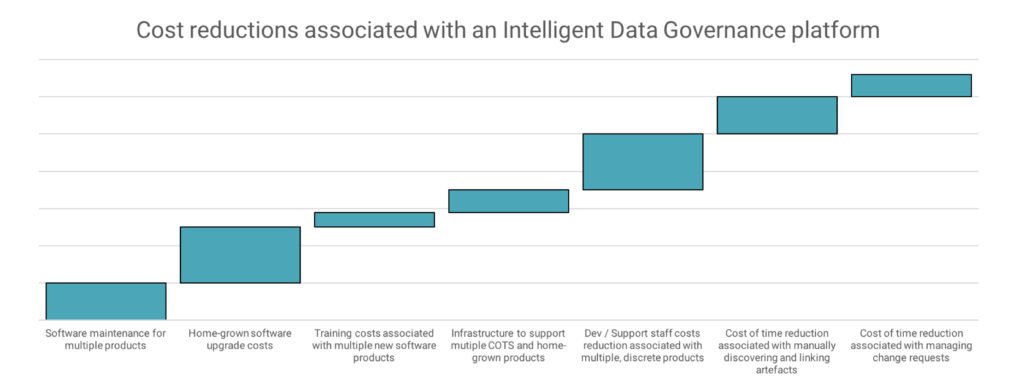 These savings, for many organizations, could run into significant sums over a short period.
These savings, for many organizations, could run into significant sums over a short period.
Next-Gen Analytics
In the modern world of Next-Gen Analytics, one common challenge is improving the efficiency of the teams involved. For many, 80% of their working day is spent finding the right data and then working the data into a form and format suitable as an input into the analytics process. The rest of the day is spend working on the delivering the outcomes i.e. developing and running the analytical models. If we have an Intelligent Data Governance capability, then organizations should be able to significantly reduce the amount of time spent finding and fixing the data they need. An Intelligent Data Governance capability will provide much of the insight needed to significantly reduce the overall data discovery process. This new capability will bring focus on data transparency, provenance and semantic clarity. It will also help with the reuse of data assets, improve data understanding, visibility of provenance regardless of whether it’s from a business or technical viewpoint, controls and data linkages (how business and technical data artefacts are logically and/or physically linked). If we can reduce the 80% figure down to 20%, we’ve suddenly freed up a huge amount more time to enable an organisation to deliver the outcomes from far more Next-Gen Analytics projects. In short, they do more projects. 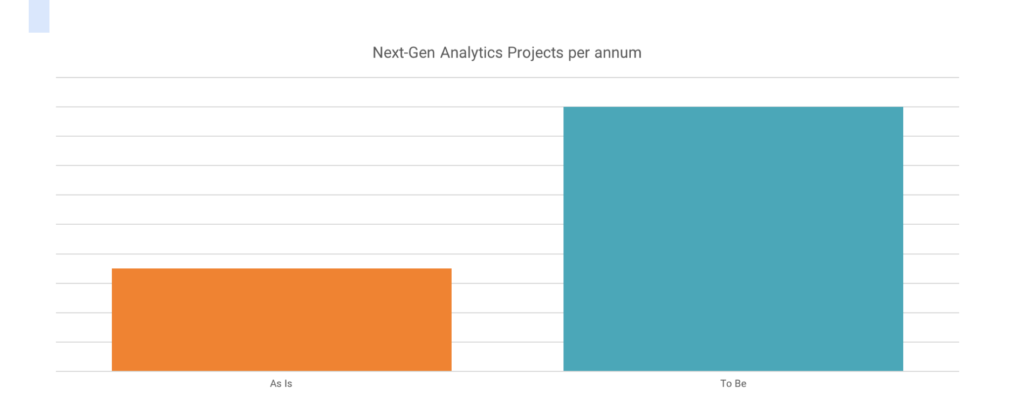 The value delivered in this initiative, is the increased value associated with the outcomes from more Next-Gen Analytics projects.
The value delivered in this initiative, is the increased value associated with the outcomes from more Next-Gen Analytics projects.
Data Quality Transformation
Many organizations are undertaking Data Quality Transformation initiatives, as part of their data-driven digital transformations, to improve the quality of key data assets to:
- Directly impact time, cost and quality of Digital Transformation initiative outcomes
- Reduce operational costs and drive operational efficiency
- Reduce process breakdowns
- Improve business decision making
To understand the impact of poor data quality, we need to consider what issues are caused during the lifecycle of data. For simplicity, I’ve broken the data lifecycle into 3 segments:
- Beginning – as data is entered or ingested into business process flows
- Middle – as data is used and consumed by business users
- End – as data is used for business strategical purposes
To get a sense of impact, we can apply the 1-10-100 rule (developed by G. Loabovitz and Y. Chang in 2014). We use this approach to help understand the financial impact of quality as data moves through an enterprise. In simple terms, is suggests that the further through an enterprise poor quality data travels, the more expensive it is. This expense could be the costs to either remediate the data or the impact on the decisions made using that data. 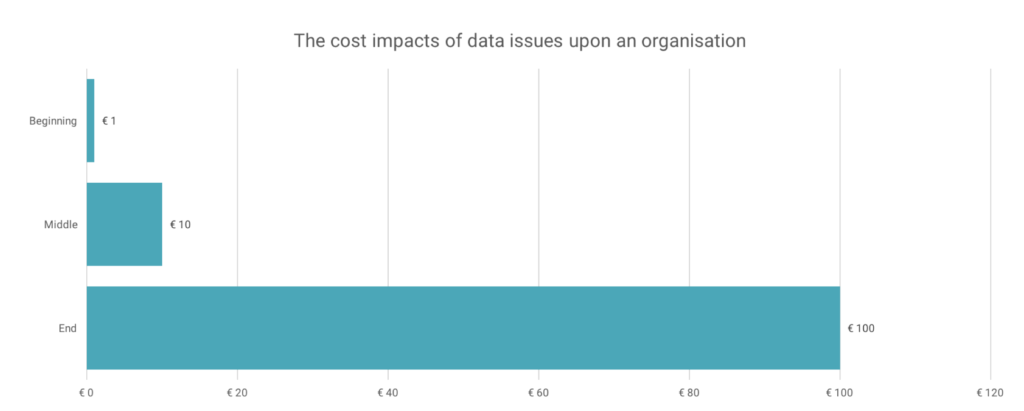 The chart above shows how inexpensive data quality issues are at the beginning of the business process but how expensive they are at the end. An Intelligent Data Governance capability would show the quality of data and how this changes, across the lifecycle of processes and systems involved. This level of insight, and with context, enables organizations to quickly understand where data quality issues are impacting business processes; so remediating action can be taken quickly.
The chart above shows how inexpensive data quality issues are at the beginning of the business process but how expensive they are at the end. An Intelligent Data Governance capability would show the quality of data and how this changes, across the lifecycle of processes and systems involved. This level of insight, and with context, enables organizations to quickly understand where data quality issues are impacting business processes; so remediating action can be taken quickly.
Customer Centricity
Many organizations are undertaking Customer Centricity programmes, as part of their data-driven digital transformation, where knowledge about the required data assets can have a direct impact upon programme value delivery. Some examples of the issues and potential causes are shown below: 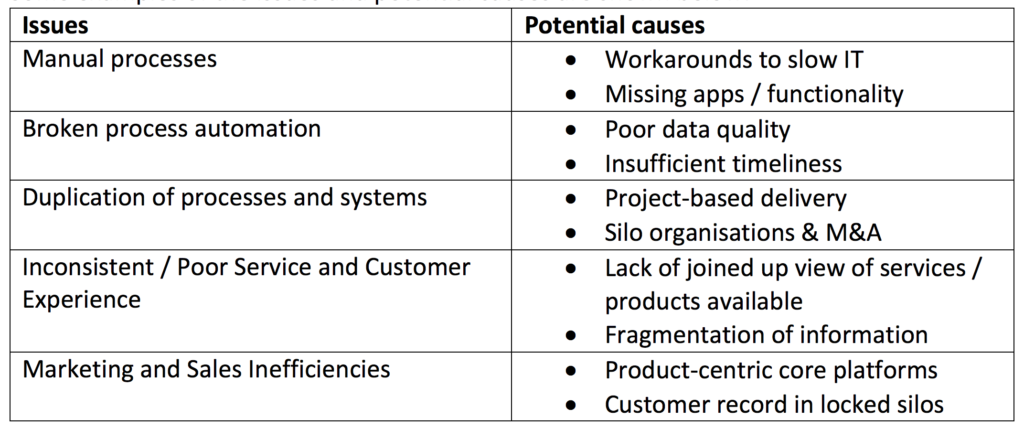 If we apply Intelligent Data Governance to the last example above, we can probably improve marketing offer take up rates due because:
If we apply Intelligent Data Governance to the last example above, we can probably improve marketing offer take up rates due because:
- Higher quality contact data means the offer is more likely to reach the recipient
- Well understood sources of trusted data are quicker and easier to access and leverage
- More sources create a bigger pool of data to draw insights from, when brought together
- Analysts have higher confidence in the data so create more time-sensitive offers that are more likely to be well received
- Understanding how data is used makes offer optimisation quicker and simpler
So, if we can use Intelligent Data Governance to improve marketing offer take up rates – what does that mean financially? Many organizations typically have low take up rates to offers, so we should now be able to improve the take up rate based upon the points above. This would potentially translate into significant sums of money when applied consistently across an organization's business operations. 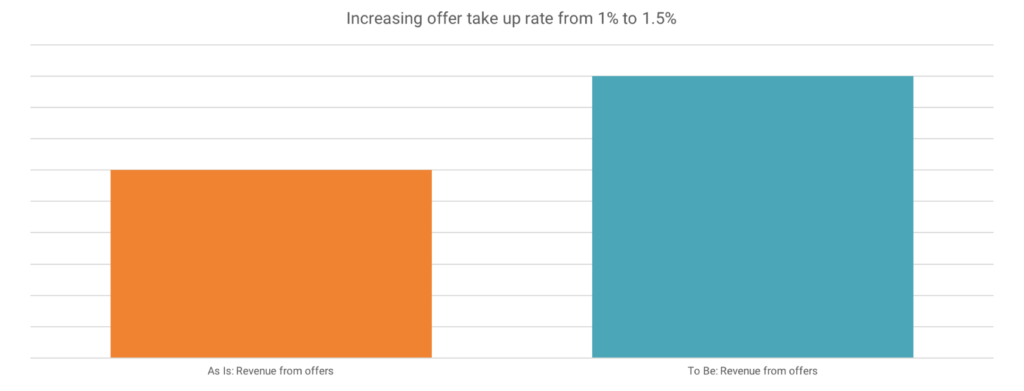 The example above shows the impact of how using Intelligent Data Governance to increase offer take up rates from 1% to 1.5%, can have a significant financial value.
The example above shows the impact of how using Intelligent Data Governance to increase offer take up rates from 1% to 1.5%, can have a significant financial value.
Intelligent Data Governance
Hopefully, this has given you some food for thought about quantifying value. If you want to know more about how Intelligent Data Governance can accelerate your data-driven digital transformation, please follow this link.








